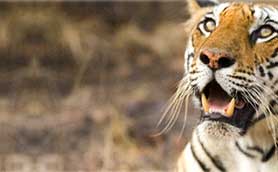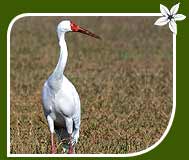  |
L-6, Samrat Bhawan, Ranjeet Nagar Commercial Complex, New Delhi - 110 008 (India) Phone : +91 9910910493 E-mail : info@indiajungletours.com |
|||||||
|
||||||||
 |
 The
Siberian Crane, scientifically called 'Grus leucogeranus', is one of the
migratory birds coming from Russia in Yakutia and western Siberia. Blessed
with unbelievable skills of flying, this beautiful world has now become one
of the critically endangered bird species. White in feather and a brick-red
in color, the Siberian Crane hypnotizes the onlookers by her innocent
creations. It winters here in the central and northern part of India.
The
Siberian Crane, scientifically called 'Grus leucogeranus', is one of the
migratory birds coming from Russia in Yakutia and western Siberia. Blessed
with unbelievable skills of flying, this beautiful world has now become one
of the critically endangered bird species. White in feather and a brick-red
in color, the Siberian Crane hypnotizes the onlookers by her innocent
creations. It winters here in the central and northern part of India. | Kingdom
: Animalia Class : Aves Family : Gruidae Species : G. Leucogeranus Phylum : Chordata |
Order :
Gruiformes Genus : Grus Latin Name : Grus leucogeranus Local Name : Siberian Saras (Hindi) |
 You
will surprise to know feeding is the most interesting activities and main
motive of their migrating from one extreme to another. The most favorite
diet of crane is the roots and the starchy swellings found on the roots of
certain plants called tubers. They also eat seeds, small mammals and
reptiles, eggs of other birds, and invertebrates, such as worms, clams,
insects, and crayfish. Originally, crane breed in Russia in Yakutia and
western Siberia and they are considered a long distance migrant. The eastern
population migrates in winter to the Yangtze River in China, the central
population to Northern and Central India and the western population in
Fereidoonkenar and Esfahan in Iran.
You
will surprise to know feeding is the most interesting activities and main
motive of their migrating from one extreme to another. The most favorite
diet of crane is the roots and the starchy swellings found on the roots of
certain plants called tubers. They also eat seeds, small mammals and
reptiles, eggs of other birds, and invertebrates, such as worms, clams,
insects, and crayfish. Originally, crane breed in Russia in Yakutia and
western Siberia and they are considered a long distance migrant. The eastern
population migrates in winter to the Yangtze River in China, the central
population to Northern and Central India and the western population in
Fereidoonkenar and Esfahan in Iran.  |
||
|
|
 |
||||
|
© India Jungle Tours. All Rights
Reserved (Terms
of Use) |